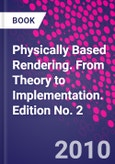Physically Based Rendering, Second Edition, describes both the mathematical theory behind a modern photorealistic rendering system as well as its practical implementation.
A method known as literate programming combines human-readable documentation and source code into a single reference that is specifically designed to aid comprehension. The result is a stunning achievement in graphics education. Through the ideas and software in this book, you will learn to design and employ a full-featured rendering system for creating stunning imagery.
This new edition greatly refines its best-selling predecessor by streamlining all obsolete code as well as adding sections on parallel rendering and system design; animating transformations; multispectral rendering; realistic lens systems; blue noise and adaptive sampling patterns and reconstruction; measured BRDFs; and instant global illumination, as well as subsurface and multiple-scattering integrators.
These updates reflect the current state-of-the-art technology, and along with the lucid pairing of text and code, ensure the book's leading position as a reference text for those working with images, whether it is for film, video, photography, digital design, visualization, or gaming.
Table of Contents
CHAPTER 01. INTRODUCTION CHAPTER 02. GEOMETRY AND TRANSFORMATIONS CHAPTER 03. SHAPES CHAPTER 04. PRIMITIVES AND INTERSECTION ACCELERATION CHAPTER 05. COLOR AND RADIOMETRY CHAPTER 06. CAMERA MODELS CHAPTER 07. SAMPLING AND RECONSTRUCTION CHAPTER 08. REFLECTION MODELS CHAPTER 09. MATERIALS CHAPTER 10. TEXTURE CHAPTER 11. VOLUME SCATTERING CHAPTER 12. LIGHT SOURCES CHAPTER 13. MONTE CARLO INTEGRATION I: BASIC CONCEPTS CHAPTER 14. MONTE CARLO INTEGRATION II: IMPROVING EFFICIENCY CHAPTER 15. LIGHT TRANSPORT I: SURFACE REFLECTION CHAPTER 16. LIGHT TRANSPORT II: VOLUME RENDERING CHAPTER 17. LIGHT TRANSPORT III: PRECOMPUTED LIGHT TRANSPORT CHAPTER 18. RETROSPECTIVE AND THE FUTURE APPENDIXES A�Utilities B Scene Description Interface C Index of Fragments D Index of Classes and their Members E�Index of Miscellaneous Identifiers








